hobby automatic movement
There are many types of movements in watches. I have had almost always ones with an automatic movement. Some automatic movement images, their technique and specifications are shown here.
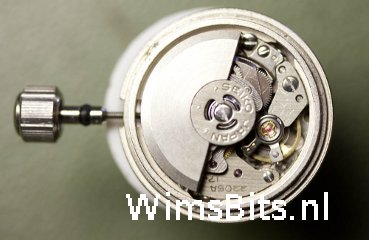
Movement: Seiko 2205-0760 back.
Manufactured: April 1977.
Bought: January 1983.
Specifications Seiko 2205-0760 automatic movement:
Features Seiko 2205-0760 movement:
automatic
Manufacturer: Seiko
date: quick set date-only mechanism
Data:
17 jewels
f = 28800 bph
size watch: approx. 33 mm
Remarks:
1970 - present
Seiko 2205-0760 with ball-bearing rotor
Image: Seiko 2205-0760 back
Website Network54.com, July 02, 2004.
The Seiko 2205 divers production started around the 1970's and ended around the 1980's.
Exact dates are unclear.
Seiko 2205 divers have written "PROFESSIONAL" on the dial.
Their hands are alike but smaller than the ones on the Seiko 6105 divers.
The divers are small/ladies size (about 33mm).
They are probably the first copies of the 150M full-size divers (such as the Seiko 6105 and Seiko 6309).
There are black dial and (rare) orange dials.
Besides the black bezel, there also is the blue-and-red bezel.
The Seiko 2205 (high-)beats at 28,800 bph and has 17 jewels.
It can be hand-wound but does not hack.
The movement is featured with a quick set date-only mechanism.
The Seiko 7s36c is said to be a good, years lasting, movement:
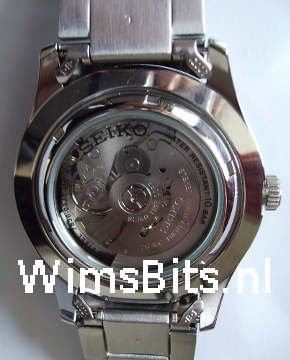
Movement: Seiko 7s36c, 23 jewels.
Manufactured: November 2019.
Bought: December 2019.
Specifications Seiko 7s36c automatic movement:
Features Seiko 7s36c movement:
Manufacturer: Seiko
Calibre: 7s36c
Number of jewels: 23
2006: Etachron regulator introduced on 7s36b
Functions: Hour, minute, second, day, date, self-winding
power-reserve 41h
Beats per hour: 21600
Size: diameter: 27,4 mm, height: 4,9 mm
Production time 7s36a: 1996
Production time 7s36b: 2006
Production time 7s36c: 2011 - 2019
Supposedly good (chronometer) (automatic) movements for watches, from everywhere:
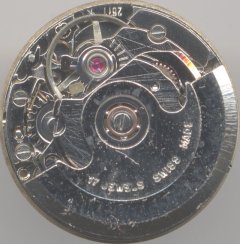
Movement: ETA 2671, 17 jewels, back. Ruby-Neutro-Shock.
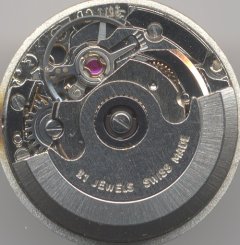
Movement: ETA 2671, 21 jewels, back.
Specifications ETA 2671 automatic movement:
Features ETA 2671 movement:
Manufacturer: ETA
Calibre: 2671
Number of jewels: 17/21
Escapement: Anchor with pallets
Balance: Nickel
Functions: Hour, minute, second, day, self-winding
Beats per hour: 28800
Size: 73/4'"
Production time: 1971 - present
Images: ETA 2671, 17 jewels and ETA 2671, 21 jewels
Website ChristophLorenz.de, September 19, 2008.
The ETA 2671 was introduced in 1971 and still works in almost every "Swiss made" self-winding ladies' watch.
It is based on 1950's developments, but represents 1970's techniques.
It beats with 28,800 bph.
The date indication has instant change and quick set.
The movement shown uses an axle beared rotor and 21 jewels.
More today's expensive versions have a ball-beared rotor and 25 jewels.
There is a simple version using only 17 jewels and a rather rare Ruby-Neutro-Shock protection system.
The first ETA automatic movement production dates from 1926, with 21,000 bph.
Automatic watches have first been sold in large quantities in 1928.
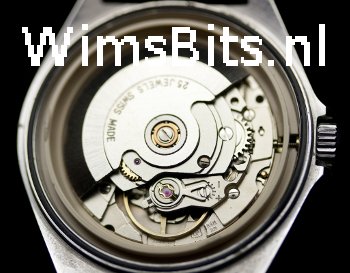
Movement: ETA 2824-2 back. (In chronometer quality available.)
Bought: July 1996.
Specifications ETA 2824-2 automatic movement:
Features ETA 2824-2 movement:
Manufacturer: ETA
Calibre: 2824-2
Number of jewels: 17, 21 or 25 (China 2824: 21) (Eterna 12824: 25)
Functions: Hour, minute, second, day, self-winding
power-reserve 40h
Beats per hour: 28800 (China 2824: 21600)
Size: diameter: 25,6 mm, 111/2'" height: 4,6 mm
(China 2824 height: 5,4 mm,
2826-2 height: 6,2 mm)
Production time ETA 2824: 1971 - 1979
Production time ETA 2824-1: 1979 - 1982
Production time ETA 2824-2: 1982 -
Production time (also made in) China 2824: 2006 -
Production time Eterna 12824: 1975 -
Production time Eterna 12825 (ETA 2824): 1975 -
Production time ETA 2826-2: 2004 -
Image: ETA 2824-2 back
Updated November 14, 2016.
This is the often encountered ETA 2824 self-winding movement.
The shown version is the common 25 jewel one.
http://www.chronometrie.com/
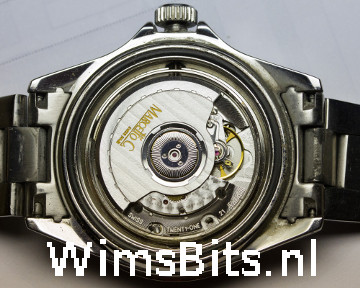
Movement: ETA 2893-2 back. (In chronometer quality available.)
Bought: April 2004.
Specifications ETA 2893-2 automatic GMT movement:
Features ETA 2892 (2893-2 GMT, 2892A2 non GMT) movement:
Manufacturer: ETA
Calibre: 2893-2
Number of jewels: 21
Functions: Hour, minute, second, day, 24h, self-winding
power-reserve 42h
Beats per hour: 28800
Size: 11.5'", Dm= 25.6mm, Do= 26.2mm, H= 4.1mm, or: H= 3.6mm
Image: ETA 2893-2 back
October 05, 2004
ranfft.de, production details:
Production time ETA 2892: 1975 - 1983
Production time ETA 2892-2: 1983 - 2000
Production time ETA 2892A2: 1999 -
Production time ETA 2893-1, (2892A2) : 2002 -
2893-2, 2893-3 (2892A2): 2002 -
Updated July 3, 2019.
http://www.chronometrie.com/
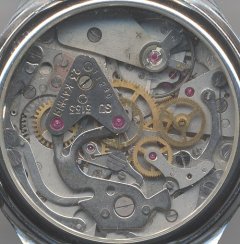
Movement: Poljot 3133 back.
Specifications Poljot 3133 mechanic movement:
Features Poljot 3133 movement:
Manufacturer: Poljot
Calibre: 3133
Number of jewels: 23
Escapement: Anchor with pallets
Functions: Hour, minute, second, day, Chronograph
Beats per hour: 21600
Size: 133/4'"
Image: Poljot 3133 back
Website ChristophLorenz.de, October 03, 2008.
The Swiss movement factory Valjoux sold around the 1970's their machines to Poljot in the USSR.
They produced the chronograph calibre 7734, now named 3133.
Since most parts are identical, this movement is quite OK, regarding the quality.
It uses a coulisse lever system.
Resulting in a quite imprecise feeling of the buttons.
It also causes the jumping of the chronograph second hand at start.
The difference with the Valjoux 7734 movement is that all chronograph related gears run now in jewels.
And the Glucydur balance swings now in a Poljot-own shock protection system.
The balance has a reduced diameter, resulting in a faster beating: 21600 bph.
The Poljot 3133 movement uses a date quick set mechanism.
This results in turning back the hands only to 23:00.
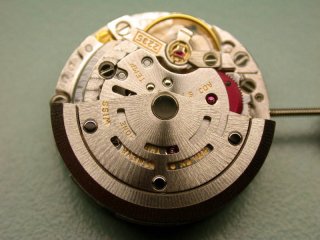
Movement: Rolex 2235 back. (In chronometer quality available.)
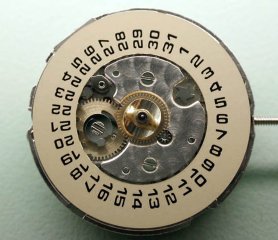
Movement: Rolex 2235 front.
Specifications Rolex 2235 automatic movement:
Features Rolex 2235 movement:
Manufacturer: Rolex
Jewels: 31
Power Reserve: Approximately 50 hours
Beats per hour: 28800
Diameter: 20mm
Casing diameter: 19.7mm
Height: 5.95mm (5.4mm for the non-date Cal. 2230)
Images: Rolex 2235 back and Rolex 2235 front
Website People.TimeZone.com, October 03, 2008.
Inside the Rolex Calibre 2235
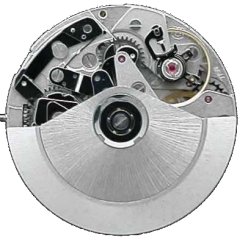
Movement: Valjoux 7750 back. (In chronometer quality available.)
Specifications Valjoux 7750 automatic movement:
Features Valjoux 7750 movement:
Jewels: 17/25
automatic chronograph, 60s, 30min, 12h, cam switched
sub second
day: quick set
date: quick set
hack feature
power reserve: 46h
Beats per hour: f = 28800 A/h
13.25'", Dm= 30mm, H= 7.9mm
Remarks: 1973 -
Image: Valjoux 7750 back
October 03, 2008
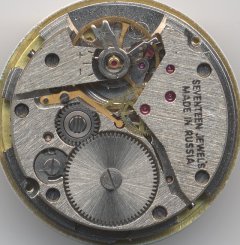
Movement: Vostok 2414 back, front.
Specifications Vostok 2414 mechanic movement:
Features Vostok 2414 movement:
Manufacturer: Vostok
Calibre: 2414
24 mm calibre sensitive movement with central second hand
Ruby jewels: 17
Date calendar: instant action
Balance: shock-resistant
Run-time reserve: not less than 38 hours
Average term of service: 10 years
Average daily rate: -10/+20 sec
Frequency: 19800 semi-oscillation per hour
Height: 4,14 mm
Image: Vostok 2414 back, front
Website WimsBezels.eu, Vostok-Inc.com and ChristophLorenz.de, December 28, 2008.
The Vostok 2414 has a diameter of 24 mm and is an anchor movement with 17 jewels.
The balance is a shock-protected Glucydur.
It has a slow changing date indication.
The second hand is in the centre and is indirect driven.
The 2414 was one of the best ones made in Russia.
In the 1990's Vostok watches were very popular, due to the numerous dial designs.
They do not break up after months like Swatches, but are almost indestructible.
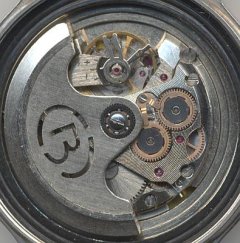
Movement: Vostok 2416 back.
Specifications Vostok 2416 automatic movement:
Features Vostok 2416 movement:
Manufacturer: Vostok
Calibre: 2416
Number of jewels: 30
Escapement: Anchor with pallets
Functions: Hour, minute, second, day, self-winding
Beats per hour: 19800
Size: 103/4'"
Image: Vostok 2416 back
Website ChristophLorenz.de, October 05, 2008.
This movement has got an expensive self-winding mechanism.
It contains ten synthetic rubies, which are integrated in the change gears.
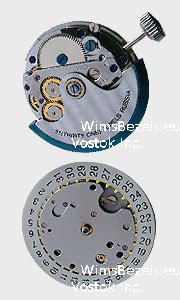
WimsBezels.eu watches
Movement: Vostok 2416B back, front.
Specifications Vostok 2416B automatic movement:
Features Vostok 2416B movement:
Manufacturer: Vostok
Calibre: 2416B
24 mm calibre sensitive movement with central second hand
Number of Ruby jewels: 31
Date calendar: instant action
Automatic movement with safety device keeping the spring safe from overwinding
Balance: shock-resistant
Run-time reserve: not less than 31 hours
Average daily rate: -10/+20 sec
Average term of service: 10 years
Beats per hour: 19800 semi-oscillation per hour
Height: 6,3 mm
Image: Vostok 2416B back and Vostok 2416B front
Website WimsBezels.eu and Vostok-Inc.com, October 05, 2008.
Watch (specification) terminology.
Balance
The balance is a very critical part of the movement. It includes the balance wheel, which quickly spins back and forth. The balance lever is the ratchet mechanism making the "tick" sound. It regulates the balance wheels turning into precise small motions per time.
Bezel
The bezel is in general present, or not, on the upper side of the watch. It is the ring around the dial, the glass. The bezel may contain other "pieces of glass:" jewels.
Chronograph
A chronograph is just a watch with stopwatch functions.
Chronometer
A chronometer is a watch containing a movement certified by COSC.
The usual men's watch movement (>20 mm diameter) must stay within -4 to +6 seconds variation per day during the COSC time measuring.
The movement <=20 mm diameter must stay within -5 to +8 seconds variation per day.
The pocket watches movement must stay within -2 to +5 seconds variation per day.
This happens at 5 different positions and 3 temperatures.
During 16 periods of 24 hours.
Most temperatures are 23 degrees Celsius, except once 38 and once 8 degrees.
Each movement is separately tested.
Crown
The crown is a knobble, usually at the right side, on the watch. It is used to adjust and wind the watch.
Hack
The hack feature causes the watch to stop running, temporarily, when you pull out the crown. In this way you can adjust it exactly.
Incabloc
Incabloc is a method to protect a watch movement against shock. It was developed in the 1930's. Other ways to protect against shock are: Parachoc, Etachoc, Kif, Unisafe and Novochoc. Incabloc protects against shock by letting the jewelled balance of the movement move laterally and vertically. This moving is in a spring-mounted fitting. Many modern movements, including ETA, use Incabloc. See also "Kif" below.
Jewels
Jewels are usually inexpensive synthetic rubies and are used in mechanic watches. They are there for virtually frictionless pivots or hubs. Most times just at the most critical places in the movements. More jewels does not mean a better watch. Around 17 jewels are needed at the bare minimum, 21 or more are needed for really good watches.
Kif
Kif is a method to protect a watch movement against shock. It was developed in the 1930's. Other ways to protect against shock are: Parachoc, Etachoc, Incabloc, Unisafe and Novochoc. Several modern movements, including Rolex, use Incabloc. See also "Incabloc" above.
Rotor Automatic
The rotor automatic is about the only type of automatic watch used today. It is a kind of "half" disc, allowing to rotate 360 degrees, in both directions. This causes winding of the movement. Activity of the wrist causes the rotor to rotate.
Expensive watches are more accurate?
All watches have the habit of losing some seconds in due course. These small mechanical or electro-mechanical apparatus count 86,400 seconds a day. When the small mechanical apparatus would be 99.75% accurate, they would be 3.6 minutes fast or slow in just 24 hours. This might already be a bit too much!
What might be a reasonable expectation of accuracy from a watch?
watch
certified (rare)